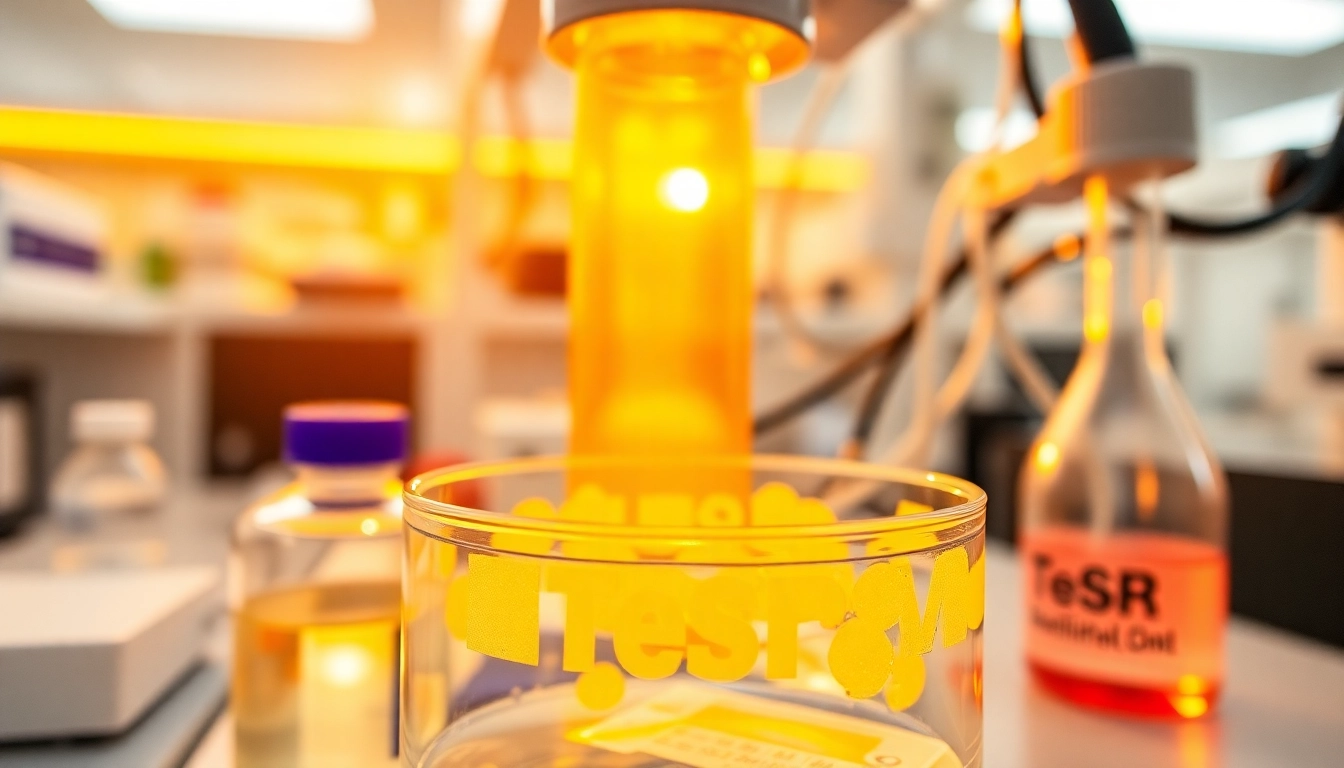Understanding TeSR™ Feeder-Free Media
The world of stem cell research has witnessed an unprecedented transformation over the last few decades, particularly with the introduction of feeder-free media designed to cultivate human pluripotent stem cells (hPSCs). One of the most innovative products in this domain is the TeSR™ family of media, which enables optimal reprogramming, maintenance, and differentiation of embryonic and induced pluripotent stem cells. By providing researchers with a rigorously developed media system, TeSR™ promotes consistency and reproducibility in stem cell cultures. For anyone interested in exploring the applications and advantages of this cutting-edge media, a comprehensive understanding of all check is essential.
What is TeSR™ Media?
TeSR™ media, developed by STEMCELL Technologies, represents a suite of feeder-free media created to support the growth and maintenance of human pluripotent stem cells. This family includes several specialized formulations, such as mTeSR™1, mTeSR™ Plus, and TeSR™-AOF, each optimized for specific applications ranging from the reprogramming of somatic cells to their long-term maintenance and differentiation. Unlike traditional culture methods that rely on feeder layers, these media provide all necessary growth factors in a defined and consistent environment. This translates to better-quality stem cell cultures and facilitates downstream applications in regenerative medicine and developmental biology.
Key Ingredients and Benefits
The formulation of TeSR™ media is rooted in the pioneering work of Dr. James Thomson and his laboratory, where it was established that a defined culture medium could significantly enhance the growth and pluripotency of hPSCs. Each media variant includes essential components such as:
- Basal medium: Provides a nutrient-rich background.
- Growth factors: Essential for promoting cell proliferation and maintaining pluripotency, including basic fibroblast growth factor (bFGF) and transforming growth factor (TGF).
- Buffering agents: Such as HEPES, which help stabilize the pH, rendering the medium suitable for long-term culture.
The advantages of using TeSR™ media extend beyond ingredient quality; researchers report improved cell morphology, enhanced viability, and greater ease in transitioning between different stages of stem cell cultures.
The Role of Cytokines in hPSC Culture
Cytokines play a pivotal role in maintaining stem cell homeostasis. In the context of TeSR™ media, they are included to regulate crucial processes such as self-renewal, pluripotency, and differentiation. For instance, the combination of bFGF and TGF cytokines supports the maintenance of hPSCs by promoting survival and preventing spontaneous differentiation. Understanding how these signaling molecules interact within the context of TeSR™ media is critical for researchers looking to harness the full potential of hPSCs.
Applications of TeSR™ Media in Stem Cell Research
TeSR™ media are not just versatile in formulation but also in their applications throughout the stem cell research workflow. They enable a seamless transition from the reprogramming of somatic cells through to differentiation into specific cell types, making them an invaluable tool for a wide range of scientific inquiries.
Reprogramming and Maintenance of iPS Cells
The process of reprogramming somatic cells into induced pluripotent stem cells (iPSCs) has been vastly simplified with the TeSR™ media. Specifically, the ReproTeSR™ medium aids in maintaining the pluripotent state of iPSCs while also allowing for efficient reprogramming if required. The use of TeSR™ media ensures that the iPSCs retain their genomic integrity and pluripotency markers throughout the culture period. This reliability is essential for researchers conducting experiments that hinge on consistent and reproducible cell behavior.
Differentiation Media for Targeted Cell Types
The differentiation potential of hPSCs can be meticulously guided by using TeSR™ media tailored toward specific lineages. Examples include:
- TeSR™-E5: This medium is optimized for the differentiation of hPSCs into definitive endoderm.
- TeSR™-E6: Designed for the differentiation into multiple cell types including definitive endoderm and mesoderm.
- ReproTeSR™: Intentionally formulated to facilitate the reprogramming and subsequent differentiation of iPSCs into various lineages.
Incorporating these specialized media into research can yield more precise outcomes in differentiation protocols, such as improved yields of target cell populations essential for regenerative therapies.
Cryopreservation Techniques Using TeSR™
A critical stage in stem cell research is the cryopreservation of stem cells. TeSR™ media provide formulations designed explicitly for maintaining cell viability during freezing and thawing processes. The mFreSR™ and FreSR™-S media have been formulated to minimize cellular damage during cryopreservation, ensuring that cells remain viable post-thawing. These products are essential for long-term storage of cell lines while retaining their functional capabilities.
Comparative Analysis of mTeSR™ Plus and Other Media
When selecting the appropriate media for hPSC culture, researchers must consider multiple factors including specific application needs, desired cellular outcomes, and regulatory compliance.
Advantages of mTeSR™ Plus Over mTeSR™1
mTeSR™ Plus is designed as an advanced version of the widely-utilized mTeSR™1. Key improvements include:
- Enhanced pH Buffering: Unlike its predecessor, mTeSR™ Plus maintains a more stable pH even during extended culture periods when media changes are skipped. This stability is crucial for preserving cellular integrity.
- Stabilized Components: Certain growth factors, such as FGF2, are enhanced in mTeSR™ Plus, leading to improved cell growth and maintenance.
- cGMP Compliance: mTeSR™ Plus is manufactured under current Good Manufacturing Practices (cGMP), ensuring a standardized quality across batches.
Performance Metrics of Various TeSR™ Solutions
Research has shown distinct performance metrics among various TeSR™ media. Performance indicators such as cell growth rates, the ability to maintain pluripotency, and differentiation efficiency are often higher in mTeSR™ Plus when compared to other systems like mTeSR™1 and TeSR™-E8™, making it a favorable option in laboratory settings.
Choosing the Right Medium for Specific Applications
The diversity of TeSR™ media can lead to confusion when selecting the right formulation. A systematic approach considers aspects such as:
– The starting cell type (e.g., iPSCs, hESCs)
– The purpose of the culture (e.g., maintenance vs. differentiation)
– Regulatory requirements (if applicable)
Understanding these parameters helps optimize the selection process, yielding more relevant and high-quality results.
Expert Insights and Interviews
Incorporating expert insights adds depth to the conversation around TeSR™ media and their applications in research. Leading researchers have shared their experiences and perspectives regarding stem cell differentiation and maintenance.
Dr. Joseph C. Wu on Hematopoietic Cell Differentiation
Dr. Joseph C. Wu emphasizes the importance of TeSR™ media in differentiating hPSCs to hematopoietic lineages. His work demonstrates that with optimized media, researchers can achieve better outcomes in deriving hematopoietic progenitor cells, which are critical for understanding blood disorders.
Dr. Andrew Elefanty on Endoderm Lineages
Dr. Andrew Elefanty focuses on differentiation towards definitive endoderm, illustrating how TeSR™ media can provide a controlled environment conducive to lineage specification. His findings indicate that the precision in media formulations can significantly impact cell-type specificity.
Dr. David Hay on Scale-Up Strategies
According to Dr. David Hay, scaling up the culture of hPSCs for therapeutic applications requires a media system that maintains quality across large volumes. He discusses how TeSR™ media’s formulation allows reproducibility and consistency essential for cellular therapies.
Quality Assurance and Regulatory Compliance
As stem cell research evolves into clinical applications, the emphasis on quality assurance and compliance has never been greater. TeSR™ products are manufactured following stringent guidelines to ensure safety and performance.
Understanding cGMP and Its Importance
Current Good Manufacturing Practices (cGMP) play a crucial role in the production of stem cell culture media. Understanding cGMP’s implications helps researchers ensure that the media fulfill both scientific and regulatory standards, ultimately protecting the end-users and subjects involved in clinical research.
Batch Consistency and Experimental Reproducibility
To minimize variability in research outcomes, batch-to-batch consistency is vital. The TeSR™ product line emphasizes rigorous testing during manufacturing processes to guarantee that each batch meets the necessary specifications for research and therapeutic applications.
Addressing Common Quality Challenges in hPSC Culture
Despite advancements, various challenges remain regarding the quality of hPSC cultures. Common issues include spontaneous differentiation, contamination, and genetic drift. TeSR™ media have been designed with these vulnerabilities in mind, providing a reliable solution to common pitfalls in stem cell research.



